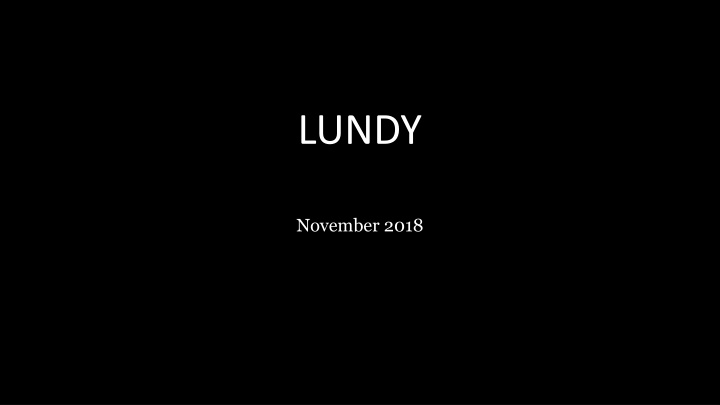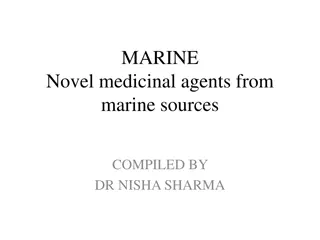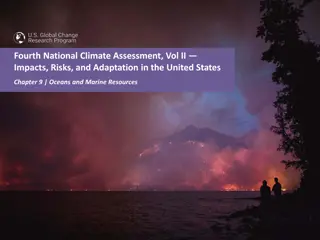Effective Management of Marine Protected Areas in the UK
The WWF's UK SEAS project aims to enhance the management of marine protected areas (MPAs) in the UK by implementing new approaches and evaluating the current management strategies in North Devon and the Outer Hebrides. The Compass Card tool helps assess progress in MPA management based on 38 criteria, categorized into three stages: Creation, Pioneer, and Self-sufficiency. By analyzing these criteria, managers can identify areas of improvement and track the development of MPAs over time.
Download Presentation

Please find below an Image/Link to download the presentation.
The content on the website is provided AS IS for your information and personal use only. It may not be sold, licensed, or shared on other websites without obtaining consent from the author.If you encounter any issues during the download, it is possible that the publisher has removed the file from their server.
You are allowed to download the files provided on this website for personal or commercial use, subject to the condition that they are used lawfully. All files are the property of their respective owners.
The content on the website is provided AS IS for your information and personal use only. It may not be sold, licensed, or shared on other websites without obtaining consent from the author.
E N D
Presentation Transcript
LUNDY November 2018
1 Identify important areas for species & habitats 2 Identify stakeholders & their interests 3 Set up stakeholder participation process 4 Assess condition of important areas for species & habitats 5 Create socio-economic baseline 6 Identify pressures impacting species & habitats 7 Set MPA boundary based on areas of ecological importance 8 Establish zoning for activities 9 Establish management rules for zoned areas 10 Create a management body to set and monitor strategy 11 Create a management committee to implement the strategy 12 Establish environmental MPA objectives 13 Established socio-economic MPA objectives 14 Identify benefit sharing rules 15 Develop alternatives for displaced activities 16 Create clear lines of responsibility for governance 17 Ensure the MPA has legal status 18 Publicly communicate about the MPA 19 Support an active & inclusive stakeholder engagement process 20 Develop a management plan 21 Ensure adequate MPA staff 22 Ensure adequate infrastructures and equipment 23 Enforce management rules 24 Create a business plan fund long-term MPA management 25 Capacity build skills needed to run the MPA 26 Create education programme linked to MPA objectives 27 Monitor biological, social and economic factors 28 Monitor management activities against performance 29 Build a sense of responsibility for the MPA by stakeholders 30 Demonstrate the authorities take responsibility for the MPA 31 Effectively implement the management plan 32 Sustain & build on community involvement 33 Demonstrate that MPA is achieving objectives 34 Demonstrate that MPA is improving ecological condition 35 Demonstrate that MPA is providing socio-economic benefits 36 Report progress to the community 37 Update management plan/rules based on monitoring data 38 Create sustainable income stream to cover management costs THE COMPASS CARD SELF-SUFFICIENT PHASE CREATION PHASE WWF s UK SEAS project is all about trying to improve how marine protected areas (MPAs) in the UK are managed. We hope to do this by testing new approaches to management in our case study areas in North Devon (with the North Devon Marine Pioneer) and in the Outer Hebrides. The first step in that journey is to understand how they are being managed at the moment, to gather baseline information on where we are doing really well, and where we could focus energy on improving. The Compass Card survey forms part of that baseline assessment. It s a pretty neat technique. PIONEER PHASE Progress is measured using 38 criteria that cover a range of management issues including things like setting objectives, collecting information, creating plans, involving stakeholders and monitoring etc. Each criteria is scored out of 3, from 0 = it is not being done, to 3 = it is being done really well. The criteria are arranged around the outside of the compass. The stages and criteria may vary somewhat from one MPA to the next, however to achieve effective MPA management all of them need to be considered at some point. A quick look at the results will tell you what stage the MPA is at (creation, pioneer or self- sufficiency) and what the MPA is doing well on and what it needs to improve. The tool can be used to track the course of MPA development over time and help managers with day-to-day organisation of their MPA by filling in the progress made year after year. The Compass Card divides the process of establishing an MPA into three stages: 1. The Creation phase : In the UK we would call that the designation process . This involves gathering all the data needed and working with stakeholders to develop management rules. 2. The Pioneer phase : The pioneer phase is when management becomes operational and the management team starts monitoring and building programmes to support delivery of the objectives. 3. The Self-sufficiency phase : By this point the MPA is well on the way to technical, organisational and financial self-sufficiency and the environmental and social benefits of the MPA are being felt.
STEPS RESPONSES 1) Original compass card edited to better reflect UK situation. 2) Four graduated answer categories created for each criterion. 3) A full and a shorter version of the survey designed using SurveyMonkey. 4) Online survey link sent to 120 contacts on the UKSEAS database and advertised on the CMS listserv in Aug 2018. 5) Survey open for 2 months & reminders sent twice. 6) Local meetings attended to encourage participation from key stakeholders. 7) Data downloaded and analysed using excel. 8) Mean scores added to compass. 18 Responses (7 short, 11 full) 6 out of 18 respondents indicated they were from North Devon Sector affiliation shown below: 9 8 7 6 5 4 3 2 1 0 The private sector Academia A public authority Civil Society (e.g. individual, NGO)
LUNDY LUNDY 1 38 2 37 3 36 4 Responses 18 35 Criteria number No response Mean score 50% unsure 5 1 70% 34 1 6 33 7 32 Creation Pioneer 8 31 Creation Self-sufficient 9 30 Pioneer 10 29 Self-sufficient 11 28 12 27 13 26 14 25 15 24 16 23 17 18 22 21 19 20
LUNDY LUNDY 1 4 36 35 6 34 2 Responses 18 33 Criteria number No response Mean score 50% unsure 1 3 70% 1 31 5 23 7 37 Set up 17 Plans & management Involving people Decision making Creation 28 20 Pioneer 27 Resources Monitoring Results 12 Self-sufficient 38 13 25 24 22 8 21 9 14 15 11 26 10 18 30 19 16 32 29
1. Were areas important for species and habitats of conservation value identified? 100 80 % of respondents 60 40 SET UP LUNDY 20 0 0 1 2 3 Unsure Score
4. Was the condition of important areas for species and habitats established? 100 80 % of respondents 60 40 SET UP LUNDY 20 0 0 1 2 3 Unsure Score
6. Were the pressures identified that impact important areas for species and habitats? 100 80 % of respondents 60 40 SET UP LUNDY 20 0 0 1 2 3 Unsure Score
2. Were stakeholders and their interests identified? 100 80 % of respondents 60 40 SET UP LUNDY 20 0 0 1 2 3 Unsure Score
3. Was a stakeholder participation process established? 100 80 % of respondents 60 40 SET UP LUNDY 20 0 0 1 2 3 Unsure Score
5. Was a socio-economic baseline report produced? 100 80 % of respondents 60 40 SET UP LUNDY 20 0 0 1 2 3 Unsure Score
7. Was the MPA boundary based on important areas of ecological interest 100 80 % of respondents 60 40 SET UP LUNDY 20 0 0 1 2 3 Unsure Score
17. Does the protected area have legal status? 100 80 % of respondents 60 40 SET UP LUNDY 20 0 0 1 2 3 Unsure Score
Do you have any thoughts or ideas on how MPAs could be set up more successfully? Provide more information on the sites themselves! Wider participation in establishing the baseline and management. Lundy should be used as a model - stakeholders must take ownership of an MPA for it to be successful. SET UP LUNDY Better research and science to support the reserve status, rather than just taking anecdotal evidence.
PLANS & MANAGEMENT 20. Does the protected area have a management plan? 100 80 % of respondents 60 40 LUNDY 20 0 0 1 2 3 Unsure Score
PLANS & MANAGEMENT 12. Does the MPA have objectives that consider environmental factors? 100 80 % of respondents 60 40 LUNDY 20 0 0 1 2 3 Unsure Score
PLANS & MANAGEMENT 13. Does the MPA have objectives that consider socio-economic factors? 100 80 % of respondents 60 40 LUNDY 20 0 0 1 2 3 Unsure Score
PLANS & MANAGEMENT 24. Does the MPA have a business plan describing how income can be generated to deliver the MPA objectives in the long term? 100 80 % of respondents 60 40 LUNDY 20 0 0 1 2 3 Unsure Score
PLANS & MANAGEMENT 8. Does the protected area have well-defined spatial units (zones) that direct the type, location and/or time of allowable human activities? 100 80 % of respondents 60 40 LUNDY 20 0 0 1 2 3 Unsure Score
PLANS & MANAGEMENT 9. Does the protected area have management in place for each zone as appropriate to meet the site's objectives as a whole? 100 80 % of respondents 60 40 LUNDY 20 0 0 1 2 3 Unsure Score
PLANS & MANAGEMENT 15. Have alternative income generating activities been considered to compensate for displacement of damaging activities in the MPA? 100 80 % of respondents 60 40 LUNDY 20 0 0 1 2 3 Unsure Score
PLANS & MANAGEMENT 26. Is there a planned education programme linked to the site's objectives and needs? 100 80 % of respondents 60 40 LUNDY 20 0 0 1 2 3 Unsure Score
PLANS & MANAGEMENT Do you have any thoughts or comments on how management plans and site objectives could be improved? No take zone completely around the island as that is what most of our customers think. LUNDY Not all MPA plans need to consider a business plan - it depends entirely on the MPA.
18. Are people aware of the MPA? INVOLVING PEOPLE 100 80 % of respondents 60 40 LUNDY 20 0 0 1 2 3 Unsure Score
19. Do deliberate (active and inclusive) opportunities for people to be involved in decision making exist? INVOLVING PEOPLE 100 80 % of respondents 60 40 LUNDY 20 0 0 1 2 3 Unsure Score
32. How satisfied are you with your involvement with MPA management? INVOLVING PEOPLE 100 80 % of respondents 60 40 LUNDY 20 0 0 1 2 3 Unsure Score
29. Do you think stakeholders feel a sense of responsibility for the MPA? INVOLVING PEOPLE 100 80 % of respondents 60 40 LUNDY 20 0 0 1 2 3 Unsure Score
Do you have any thoughts or comments on how we could better involve people in MPA management? INVOLVING PEOPLE Advisory groups work very well as do accreditation schemes for local operators as it gives them a sense of purpose and ownership. Perhaps the existence of the Advisory (Stakeholders) Group could be better publicised to a wider public. However, there is only space for so many at the meetings! Lundy might be unusual in having both the Lundy Management Forum and the MPA Advisory Group which means a lot meetings and efforts to co-ordinate across groups but it seems to work well and has good participation - so a useful model for other MPAs. LUNDY More information available for the public onsite about the designations and reasons for the designations. Not sure really how to engage with more people, better awareness, social media, campaigns? Direct discussion with users and feedback to know whether anything has been taken onboard.
16. Is responsibility for the governance of the MPA clear? DECISION MAKING 100 80 % of respondents 60 40 LUNDY 20 0 0 1 2 3 Unsure Score
30. Do the relevant authorities take responsibility for the MPA? DECISION MAKING 100 80 % of respondents 60 40 LUNDY 20 0 0 1 2 3 Unsure Score
10. Does a management body exist that is empowered to set the MPA s strategy, objectives and overall direction? 100 DECISION MAKING 80 % of respondents 60 40 LUNDY 20 0 0 1 2 3 Unsure Score
11. Does a management committee exist that implements the strategy? DECISION MAKING 100 80 % of respondents 60 40 LUNDY 20 0 0 1 2 3 Unsure Score
14. MPAs generate "benefits" e.g. fish and recreational opportunities. Were rules identified to help share access to these benefits? 100 DECISION MAKING 80 % of respondents 60 40 LUNDY 20 0 0 1 2 3 Unsure Score
Do you have any thoughts or comments on how we could improve decision making? DECISION MAKING This would need thought and discussion with the various organisations involved in management. LUNDY
21. Are there enough people employed to manage the site? 100 80 % of respondents RESOURCES 60 40 LUNDY 20 0 0 1 2 3 Unsure Score
22. Is the infrastructure and equipment needed to manage the site available? 100 80 % of respondents RESOURCES 60 40 LUNDY 20 0 0 1 2 3 Unsure Score
25. Do staff have the skills and training needed? 100 80 % of respondents RESOURCES 60 40 LUNDY 20 0 0 1 2 3 Unsure Score
38. Is there long term funding for the full cost of the MPA and its management/operating costs? 100 80 % of respondents RESOURCES 60 40 LUNDY 20 0 0 1 2 3 Unsure Score
Do you have any thoughts or comments on how MPA management could be better resourced? More staff and funding is needed to support the MPA. RESOURCES Endless discussions about this in all the management committee meetings! LUNDY Private funding.
27. Are biological, social and economic factors monitored which could be used in management? 100 80 MONITORING % of respondents 60 40 LUNDY 20 0 0 1 2 3 Unsure Score
28. Are management activities monitored against performance by those responsible for the management? 100 80 MONITORING % of respondents 60 40 LUNDY 20 0 0 1 2 3 Unsure Score
37. Has the management plan/rules for the protected area been reviewed and updated based on monitoring of the plan's progress? 100 80 MONITORING % of respondents 60 40 LUNDY 20 0 0 1 2 3 Unsure Score
23. Is enforcement of management rules undertaken? 100 80 MONITORING % of respondents 60 40 LUNDY 20 0 0 1 2 3 Unsure Score
Do you have any thoughts or comments on how marine protected areas could be monitored better? Funding and resources are needed to ensure effective enforcement, however if all stakeholders are engaged effectively then they self-police the MPA. MONITORING LUNDY Another ongoing topic of discussion .... Better funding
31. Is the protected area meeting its objectives/in good condition, thanks to the implementation of the management plan or rules? 100 80 % of respondents 60 RESULTS 40 LUNDY 20 0 0 1 2 3 Unsure Score
33. Is the MPA achieving its objectives (whether it has a management plan or not) 100 80 % of respondents 60 RESULTS 40 LUNDY 20 0 0 1 2 3 Unsure Score
34. Is the MPA delivering improved ecological effects? 100 80 % of respondents 60 RESULTS 40 LUNDY 20 0 0 1 2 3 Unsure Score
35. Has the MPA generated any *socio-economic benefits? *Things like culture, jobs and recreational use 100 80 % of respondents 60 RESULTS 40 LUNDY 20 0 0 1 2 3 Unsure Score
36. Are the benefits of the MPA reported to the community? 100 80 % of respondents 60 RESULTS 40 LUNDY 20 0 0 1 2 3 Unsure Score
Do you have any thoughts or ideas on how we could achieve better results? RESULTS LUNDY























